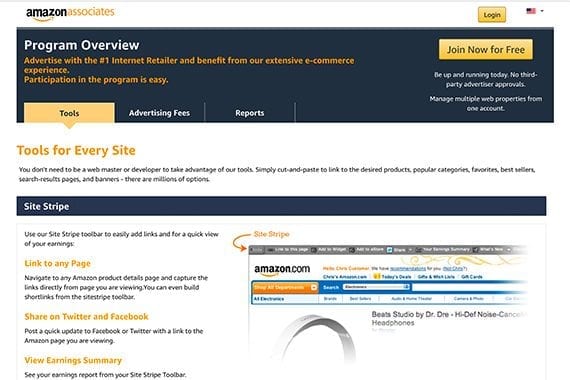Affiliate marketing is a promotional model that connects merchants with independent marketers who are willing to invest time and money to sell a merchant’s products.
Put another way, affiliate marketing connects a business that has a product to sell with a marketer who can sell it.
Affiliate marketing is performance based. Thus advertisers only pay when affiliates deliver a specified customer action. In the ecommerce context, this action is typically an online purchase, which makes affiliate marketing very cost effective.
Payments to Affiliates
The approach to affiliate payments just described is often called pay-per-sale. It is by far the most popular form of affiliate compensation. Some estimates suggest that more than 80 percent of affiliate programs are pay-per-sale.

Amazon has had a robust affiliate marketing program since 1996. It was one of the first such programs and is now among the world’s largest.
For example, Amazon, which operates one of the world’s largest ecommerce affiliate programs, pays affiliates a percentage of each “qualified sale.” The exact percentage varies, but according to the Amazon Associates website, affiliates can earn up to 10 percent.
The term “qualified sale” (or its synonym, “qualified purchase”) is important in the affiliate marketing context because the advertiser (the ecommerce merchant) defines in advance what constitutes a qualified sale. When an affiliate agrees to promote the merchant’s products, that affiliate is accepting the merchant’s definition of a “qualified sale.”
Given the mutual dependence on what “qualified sale” means (or “qualified purchase”), it is important for advertisers to carefully define how an affiliate will be paid. Returning to Amazon’s program, the company spells out which sales qualify for affiliate payments.
Here are examples of what might define a qualified purchase.
- The customer clicks a specific affiliate link.
- The product purchased must be added to the shopping cart during a single session following the aforementioned click.
- The customer must pay for and receive the product purchased.
- The customer does not return the product.
Affiliate Ads
Once an affiliate marketer understands how to get paid, she will begin promoting the advertiser’s products. Within the bounds of the program, the affiliate may choose any number of advertising and marketing channels, including but not limited to:
- Pay-per-click ads placed on the merchant’s behalf,
- Digital banner ads on content sites,
- Video ads on YouTube or similar,
- Social media posts,
- Or promotional, “advertorial” content.
It is for this reason that some experts refer to affiliate marketing as a model rather than an advertising channel, since a good affiliate may use many promotional channels to drive sales.
A merchant should also understand that affiliates seek a strong return on investment. They are spending their own money and investing their resources to generate sales. Thus they will place ads and promotions where they work best, even if that means competing with the merchant’s own advertising.

An affiliate marketer will invest her time and money into promoting the merchant’s products in exchange for payments on qualified sales. Affiliates work to generate a solid return from the ads they place and earn their living, if you will, on the difference between what a merchant pays per qualified sale and the amount of promotion it took to generate that sale.
Managing Affiliates
Affiliate marketing management requires both software and time. Let’s look at software first.
Advertisers — i.e., online retailers — need a way to recruit affiliate marketers, track their sales, and process commissions for qualified sales.
Effectively, these advertisers have a couple of choices. They can use an affiliate network that acts as a go-between, connecting the advertiser to affiliate marketers and managing the tracking and payments in exchange for a service fee. Or the advertiser can license affiliate-tracking software to deploy on its own servers or as a cloud-based service.
In this second scenario, the software will do the work of tracking affiliate payments, but the advertiser will need to recruit affiliate marketers and manage the payment process.
Both choices require work. This is the “time” required to manage an affiliate marketing program as opposed to the software used.
Affiliates will need to understand the advertiser’s target customers, the advertiser’s products, and the advertiser’s brand.
To help, a merchant could provide “talking points” that describe the brand and the products. The merchant may also create approved banner ads and otherwise provide graphics and advertising material.
The merchant will likely need to answer affiliate questions, approve some affiliate marketing tactics, and even approve individual websites where banners may appear.
And like any other form of ecommerce marketing, a merchant’s marketing team will need to track performance. Is affiliate marketing generating the desired return on investment? Is it supporting the store’s brand?




